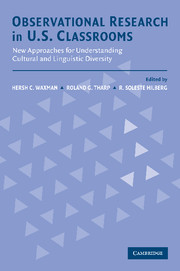 Observational Research in U.S. Classrooms
Observational Research in U.S. Classrooms Book contents
- Frontmatter
- Contents
- Tables, Figures, and Appendixes
- Contributors
- 1 Introduction: Purposes and Perspectives on Classroom Observation Research
- 2 Using Multiple Perspectives in Observations of Diverse Classrooms: The Sheltered Instruction Observation Protocol (SIPO)
- 3 The Standards Performance Continuum: A Performance-Based Measure of the Standards for Effective Pedagogy
- 4 The Uses of the Classroom Observation Schedule to Improve Classroom Instruction
- 5 Development and Use of a Classroom Observation Instrument to Investigate Teaching for Meaning in Diverse Classrooms
- 6 Patterns of Language Arts Instructional Activity and Excellence in First– and Fourth–Grade Culturally and Linguistically Diverse Classrooms
- 7 Using Classroom Observation as a Research and Formative Evaluation Tool in Educational Reform: The School Observation Measure
- 8 Observing School Restructuring in Multilingual, Multicultural Classrooms: Balancing Ethnographic and Evaluative Approaches
- 9 Sociocultural Activity Settings in the Classroom: A Study of a Classroom Observation System
- 10 The Influence of School Reform on Classroom Instruction in Diverse Schools: Findings from an Observational Study of Success for All
- 11 Future Directions for Classroom Observation Research
- Index
- References
4 - The Uses of the Classroom Observation Schedule to Improve Classroom Instruction
Published online by Cambridge University Press: 23 November 2009
- Frontmatter
- Contents
- Tables, Figures, and Appendixes
- Contributors
- 1 Introduction: Purposes and Perspectives on Classroom Observation Research
- 2 Using Multiple Perspectives in Observations of Diverse Classrooms: The Sheltered Instruction Observation Protocol (SIPO)
- 3 The Standards Performance Continuum: A Performance-Based Measure of the Standards for Effective Pedagogy
- 4 The Uses of the Classroom Observation Schedule to Improve Classroom Instruction
- 5 Development and Use of a Classroom Observation Instrument to Investigate Teaching for Meaning in Diverse Classrooms
- 6 Patterns of Language Arts Instructional Activity and Excellence in First– and Fourth–Grade Culturally and Linguistically Diverse Classrooms
- 7 Using Classroom Observation as a Research and Formative Evaluation Tool in Educational Reform: The School Observation Measure
- 8 Observing School Restructuring in Multilingual, Multicultural Classrooms: Balancing Ethnographic and Evaluative Approaches
- 9 Sociocultural Activity Settings in the Classroom: A Study of a Classroom Observation System
- 10 The Influence of School Reform on Classroom Instruction in Diverse Schools: Findings from an Observational Study of Success for All
- 11 Future Directions for Classroom Observation Research
- Index
- References
Summary
Systematic classroom observation methods have been widely used in the past several decades to investigate effective teaching practices (Brophy & Good, 1986; Stallings & Mohlman, 1988; Waxman, 1995; Waxman & Huang, 1999). One of the most important uses of the method has been to determine which teaching practices improve student learning (Waxman & Huang, 1999). Most classroom observation instruments typically focus on the teacher as the unit of measurement or observation, and thus they describe a variety of instructional behaviors in which teachers engage. There are limitations, however, with teacher-based classroom observation instruments. First, teacher-focused instruments suggest that teaching practices directly impact student outcomes, without acknowledging that student behaviors impact teacher behaviors as well. Another concern with teacher-focused observation systems is that they often ignore student behaviors that have a greater impact on student outcomes than teacher behaviors.
Another limitation of teacher-based observation instruments is that they generally do not allow researchers to examine individual student behaviors, particularly differences by critical attributes such as student sex, ethnicity, or grouping classification (e.g., gifted/nongifted, resilient/nonresilient, monolingual/bilingual). A final concern with teacher-centered observation systems is that they are often very threatening to classroom teachers. Many teachers are reluctant to volunteer to participate in classroom observation research because they know the focus of attention is on the teachers and their instructional practices.
This chapter describes the uses of a systematic classroom observation instrument, the Classroom Observation Schedule (COS), that was designed to address some of the previous concerns of classroom observation by specifically focusing on individual students rather than the teacher (Waxman, Wang, Lindvall, & Anderson, 1990a, 1990b).
- Type
- Chapter
- Information
- Observational Research in U.S. ClassroomsNew Approaches for Understanding Cultural and Linguistic Diversity, pp. 72 - 96Publisher: Cambridge University PressPrint publication year: 2004
References
- 14
- Cited by
